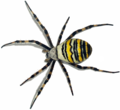Top Qs
Timeline
Chat
Perspective
Mollisoniida
Extinct order of chelicerates From Wikipedia, the free encyclopedia
Remove ads
Mollisoniida is an extinct order of total group chelicerates, living from the mid-Cambrian to Early Ordovician.

The clade is united by the presence of various characteristics. These include an elongated dorsal exoskeleton, seven articulating tergites (upper body plates corresponding to body segments) and similarly sized cephalic (head) and pygidial (tail) shields,[1] in addition to only having three pairs of walking legs and the rest of the limbs being used as gills (which likely places them nearest to Euchelicerata, due to sharing similar arrangements of limbs). The clade is relatively diverse, containing three (possibly four) genera. Mollisonia and Thelxiope are both known from four species extending from Cambrian to Ordovician,[2] with Thelxiope being very spiny and often with a shortened body. Mollisonia, on the other hand, barely has any spines at all, and (with the exception of Mollisonia plenovenatrix[3] and Mollisonia sinica, which are similarly shaped to Thelxiope) has a relatively elongated body. Corcorania is purely Ordovician, with an elongate body, a small pygidial shield, and three large spines on its cephalic shield.[4] Esmeraldacaris is also purely Ordovician,[5] although its position in the clade is uncertain. However, it seems to be similar in shape to the more compact Mollisonia species, alongside having an equally sized cephalic and pygidial shield and seven tergites, therefore a mollisoniid affinity is most likely for it. Urokodia was formerly included in this clade as a basal member (due to having 14 tergites instead of the standard seven), until a 2024 study reclassified it as the basalmost member of Artiopoda.[6]
Although Mollisoniida has been argued in some studies to be a group of stem-group chelicerates,[7] A 2025 study have argued them to be crown group chelicerates, more closely related to arachnids than to horseshoe crabs and sea spiders, based on intepretation of preserved neutral anatomy in Mollisonia.[8]
Cladogram after O’Flynn et al, 2023, showing Mollisonia (and by extension Mollisoniida) as stem group members of Chelicerata.[7]
| Total group Arthropoda |
| |||||||||||||||||||||||||||||||||||||||||||||||||||||||||||||||||||||||||||||||||||||||
Cladogram after Strausfeld et al. (2025), showing Mollisoniida as nested within Chelicerata as close relatives of modern arachnids.[8]
| Arthropoda |
| ||||||||||||||||||||||||||||||||||||||||||
Remove ads
References
Wikiwand - on
Seamless Wikipedia browsing. On steroids.
Remove ads

















